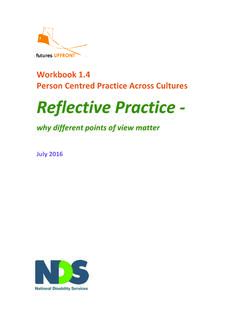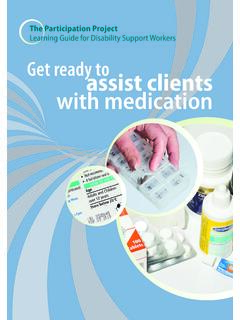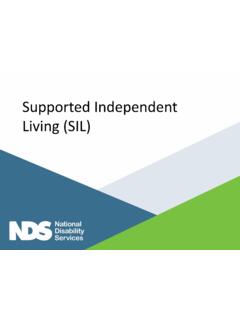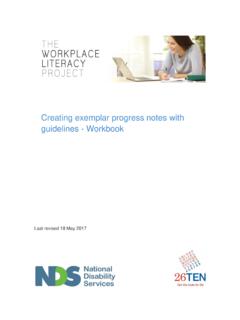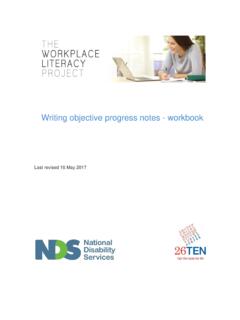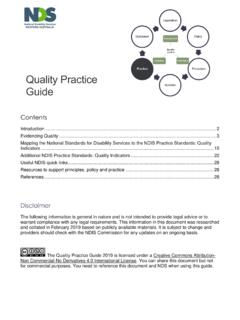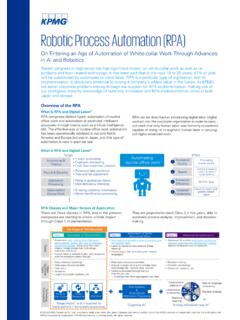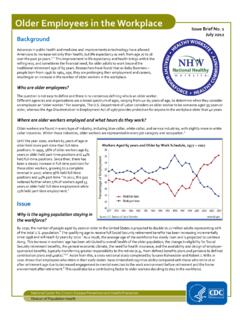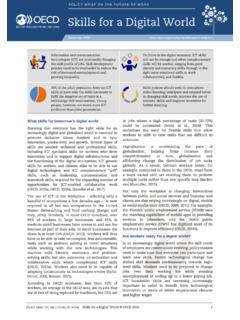Transcription of Classification of Disability Support Work in a High ...
1 Classification of Disability Support Work in a High Performance Model of Work Organisation Page 2 of 17 CONTACT INFORMATION Caroline Alcorso National Manager, Workforce Development Phone: 02 9256 3180 Email: This publication is copyright All rights reserved. Except as provided in the Copyright Act 1968 (Commonwealth), no use of this work, which is within the exclusive right of the copyright owner, may be made. ACKNOWLEDGEMENT NDS would like to acknowledge Michael Pegg from jobs Australia, the author of this report. Page 3 of 17 Contents Classification of Disability Support work in a high performance model of work organisation .. 1 Introduction .. 4 Background .. 4 Overview of the Classification of Disability Support work .. 5 Award classifications .. 6 What does Level 2 require in relation to Disability Support work?
2 7 Skills of Disability Support workers .. 7 Supervisory responsibilities .. 9 How do SACS levels 2 and 3 differ for Disability work? .. 9 Team leaders/coaches .. 13 Conclusion .. 14 Page 4 of 17 Introduction NDS sought jobs Australia s advice regarding two matters that are important for Disability organisations trialling or considering self-organising teams or other forms of high performance work organisation. We asked jobs Australia to advise on the following general questions (as well as a number of sub-issues) which have emerged from provider practice: The consistency of certain responsibilities with job classifications under the SCHADs award Industrial good practice regarding introducing a transition to a self-directed team form of work organisation. What follows is the background to this request and jobs Australia s considered response.
3 It should be noted that at the time of publication the Modern Award review process was still underway. The award clauses discussed below may therefore change and should be checked once the award review is complete. Background NDS is working with providers in the sector to consider and potentially introduce models of client Support and work organisation that have the following features: 1. Front line workers adopt a self-organising style of working where a range of decisions about client Support are made at the front line either individually, or following discussion with other workers. Such decisions are made within a well-articulated and shared framework of values and principles regarding supporting people with Disability . 2. In many, but not all, cases people work in self-organising teams, with or without a team leader 3.
4 The front line manager s role is one of mentor and coach with less emphasis on their accountability and supervisory responsibilities. This is the case both where teams have a team leader, and where there is a coordinator or team leader working across self-managing teams 4. Front line workers are responsible for meeting, as far as possible, the needs of the client through working with other team members; this usually involves making changes to the hours and days when services are provided, in liaison with team members and/or other staff, and will be within rostering rules 5. Front line workers are responsible for understanding their own learning needs and those of their team and seeking assistance from coaches and/or trainers to address these 6. Front line workers understand and can distinguish acceptable risks within a human rights framework from unacceptable risks that could endanger the client and/or the organisation 7.
5 Front line workers engage strongly with family members, informal carers and the community around the client to Support people with Disability to be active within and supported by mainstream services and the community broadly. Page 5 of 17 The aim of such models is firstly to improve the quality of client Support and enact more client-centred services; and secondly to reduce the amount of administrative Support needed to manage the business requirements associated with direct care work. Ultimately NDS believes that this model could deliver a service model that is both more rewarding and empowering for workers, as well as beneficial for clients, and more cost-efficient for providers and the government. Overview of the Classification of Disability Support work This discussion assumes that the Classification structure of the Social, Community, Home Care and Disability Services Industry Award 2010 (SCHADS) applies.
6 Some enterprise agreements may have different Classification structures. SCHADS originally had five Classification streams including a Disability services stream. In 2010 the award was varied to remove the separate Disability services structure and merge relevant definitions into the Social and Community Services (SACS) structure. Two streams are potentially relevant to this discussion. SACS covering roles in social welfare, community development, and Disability services at a range of skill levels such as unskilled, para professional and professional, together with clerical, administrative and managerial roles. Home Care covering work of the type that historically was funded through the Home and Community Care (HACC) program, including personal care and domestic assistance. Home Care classifications do not apply where the Support is provided in accordance with an individual care plan for the provision of Disability Support , such as supports aimed at promoting independent living skills, and/or social inclusion.
7 Importantly, a variation was inserted into the definition of the SACS sector to clarify that the mere fact of provision of Support in a private residence did not alter the application of the SACS Classification stream. Disability Support work is classified under the SACS stream regardless of the location of the work. The rest of this paper therefore only considers the SACS Classification structure. Much frontline Disability Support work is classified at SACS Level 2, and team leaders are typically at Level 3, although there have been exceptions in some areas such as in mental health, or in areas where a competitive labour market has encouraged some employers to overclassify in order to attract workers. The issue to be considered here is whether working in a high performance, self-organising team environment requires skills sufficiently higher than standard Disability Support work to require Classification at SACS Level 3.
8 Page 6 of 17 In addition, the question arises as to whether the team leader/coordinator roles in a high performance model also require higher skills than is traditional, so that they should be classified at SACS Level 4 rather than 3. Award classifications A job is classified on the basis of the overall skills and responsibilities required. Once the Classification is determined, awards then set the minimum rate of pay that is required. Nothing prevents an employer from choosing to pay a higher rate (although NDIA maximum prices can be a constraint). Most modern awards use Classification structures that since the 1990s notionally align with the competencies and skills set out by the Australian Qualifications Framework (AQF). The AQF therefore provides part of the rationale for how work is classified.
9 It is not the full story but needs to be factored into any discussion of Classification . The AQF framework provides a way for the Fair Work Commission (FWC) to set skills-based pay relativities that are consistent across industries. A key relativity is the pay rate for work that requires a trade certificate (Certificate III) or equivalent. This is sometimes referred to as the C10 relativity. A further key relativity is C9 which sets the minimum pay rate for a job which requires a post-trades certificate (Certificate IV). The following table illustrates how the relativities work within the SACS Classification structure of SCHADS compared with two other examples of modern awards, showing the minimum Classification level and fulltime rate of pay. The Manufacturing award is shown because it is a widely used standard for this purpose.
10 The Higher Education General Staff (HEGS) award is shown because it is an example of an award covering a range of technical and white collar workers. SCHADS Manufacturing Higher Education General Staff Certificate III entry Level $ Level $ Trades 1 $ HE Level $ Certificate IV entry Trades 2 $ Level $ These Classification levels which are comparable to SACS Level 2 cover trades and advanced trades people under the Manufacturing Award, and typical job roles under the HEGS Award include Technical Assistant, Tradesperson and Administrative Assistant at HE Level 3, and Technical Officer and Advanced tradesperson at HE Level 4. It is worth noting that both the Higher Education and Manufacturing awards set the Certificate III and Certificate IV minimum rates at different Classification levels, whereas SCHADS sets them at different pay points within the single Classification of SACS Level 2.

